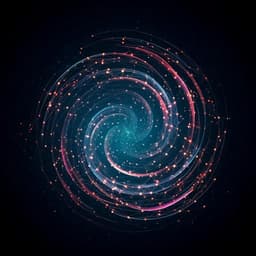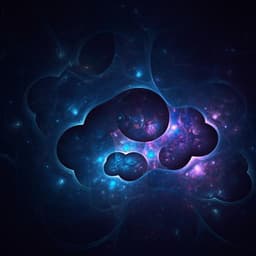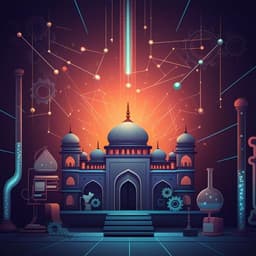
Engineering and Technology
Unleashing the healing potential: Exploring next-generation regenerative protein nanoscaffolds for burn wound recovery
L. Si, X. Guo, et al.
This groundbreaking research by Liangwei Si, Xiong Guo, Hriday Bera, Yang Chen, Fangfang Xiu, Peixin Liu, Chunwei Zhao, Yasir Faraz Abbasi, Xing Tang, Vito Foderà, Dongmei Cun, and Mingshi Yang reveals that α-lactalbumin-based electrospun nanofibrous scaffolds significantly outperform other regenerative protein scaffolds in healing burn wounds, thanks to their ability to boost serotonin production at wound sites.
~3 min • Beginner • English
Introduction
Severe burns cause debilitating, often life-threatening injuries and require effective wound management. Nanofibrous dressings, especially electrospun scaffolds, offer high surface area, porosity, gas exchange and infection barrier, mimicking extracellular matrix and supporting cell adhesion and migration. Polycaprolactone (PCL) is widely used for electrospun dressings due to spinnability and mechanics but is hydrophobic, limiting cell adhesion; blending with hydrophilic biopolymers can improve performance. α‑Lactalbumin (ALA), a tryptophan-rich milk protein and serotonin precursor, has shown promise in burn wound healing, potentially via serotonin-mediated fibroblast proliferation and angiogenesis. The study asks whether ALA’s superior burn healing derives from unique properties versus other regenerative proteins (lysozyme, bovine serum albumin, collagen I), and investigates mechanisms, focusing on serotonin production, tissue maturation and angiogenesis in a third-degree burn model.
Literature Review
The authors contextualize electrospun nanofiber dressings as advantageous for severe burns due to ECM-like architecture and barrier properties. PCL, PLA, PLGA have been used, with PCL favored for mechanics but constrained by hydrophobicity; blending with hydrophilic proteins improves wettability and bioactivity. Prior work showed ALA-based nanofibers improved deep second-degree burn healing and reduced scarring, but mechanisms remained unclear. ALA serves as a serotonin precursor; serotonin promotes fibroblast proliferation, migration and angiogenesis in burns. Comparators include lysozyme (structurally related to ALA, antibacterial, anti-inflammatory), bovine serum albumin (biocompatible, enhances biohybrid nanofiber bioactivity), and collagen I (ECM main component, clinical gold standard in many skin dressings). This study systematically compares ALA to LZM, BSA, and COL in identical PCL nanoscaffolds to discern unique versus generic protein effects.
Methodology
Materials: ALA (≥92.5%), LZM (20,000 U/mg), BSA (≥98%), COL (>90%), PCL (Mn≈80,000), solvent HFIP; various staining reagents and antibodies; commercial Collagen sponge R (CS R) as positive control.
Electrospinning of ENs: Protein/PCL mass ratio 1:3 (w/w) dissolved in HFIP, stirred overnight to transparency. Solutions loaded in 5 mL syringes; electrospinning at 15 kV, 0.4 mL/h, 15 cm tip-to-collector distance, roller collector 100 r/min, ambient 25±5 °C and 40%±10% RH. Mats vacuum-dried 72 h. Pure PCL ENs prepared similarly without protein.
Characterization:
- Morphology: FESEM (12 kV) after Au-Pd sputter coat; fiber diameters measured from >100 fibers using ImageJ.
- Physicochemical: XRD (Cu-Kα, 45 kV, 40 mA, 2θ 3–50°, 1°/min), DSC (0–280 °C, 10 °C/min, ~5 mg), FTIR (4000–500 cm−1), Raman spectroscopy.
- Secondary structure: ENs (100 mg) immersed in 5 mL PBS (pH 7.4) at 37 °C for 6 h to extract proteins; protein content via BCA assay; Far-UV CD (190–250 nm, 50 nm/min) with BeStSel analysis for α-helix/β-sheet content.
- Wettability: Water contact angle (10 μL droplet) measured over time.
- Water absorption rate (WAR): 1×1 cm samples immersed in 8 mL PBS at 37 °C for 1 h; WAR=(Wwet−Wdry)/Wdry×100%.
- Water vapor transmission rate (WVTR): ASTM E96; circular 3 cm discs sealed on bottles containing 4.5 mL water; incubated 37 °C, 50% RH for 24 h; WVTR= m/(t×A).
- Mechanical properties: Rectangular 10×20 mm samples; thickness via micrometer; tensile testing on Texture Analyzer (4,500 g load cell), strain rate 0.2 mm/s; derive elongation (%), tensile strength (MPa), Young’s modulus (GPa).
Cell assays:
- Fibroblast proliferation: NIH-3T3 cells (2×10^3 cells/well, 96-well). EN extracts prepared by soaking ENs in culture media for 7 d; pure protein solutions prepared at matched protein concentration (3.0 mg/mL). Incubations for 24 h and 72 h; CCK-8 for 1.5 h; OD at 450 nm; viability=ODtest/ODcontrol×100%.
- Cell adhesion on ENs: NIH-3T3 at 2.25×10^4 cells/well seeded on 20 mm EN discs in 12-well plates; after 48 h, LSCM after fixation (4% paraformaldehyde) and staining (FITC-phalloidin, DAPI); FESEM after glutaraldehyde fixation.
Animal model and in vivo assays:
- Third-degree burn model: Male SD rats (200±10 g), ethics-approved. Metal punch (area 379.94 mm^2) at 80 °C pressed at 10 kPa for 18 s on shaved back; after 1 h, necrotic skin excised. Silicone ring splint fixed with bio-glue to minimize contraction. ENs (22 mm diameter) applied and secured initially with elastic bandage; bandage removed next day.
- Groups (n=12 each): blank (no scaffold), PCL ENs, LZM/PCL ENs, BSA/PCL ENs, COL/PCL ENs, ALA/PCL ENs, CS R (positive control). Rats housed individually at 25 °C; gentamicin 0.15 g/L in water; daily weight monitoring. Wound photos at days 7, 14, 21; wound area and closure quantified in ImageJ; simulation plots generated.
Histology and biomarkers:
- H&E staining: paraffin sections (5 μm); re-epithelialization rate E%=Li/L0×100%.
- Serotonin ELISA: total protein extracted with RIPA+protease inhibitor; ELISA with HRP-labeled antibody, TMB substrate; absorbance at 450 nm.
- Masson’s trichrome: total collagen assessment.
- Picrosirius Red (Sirius red) under polarized light: collagen I (yellow/red) vs III (green); collagen I/III ratio quantified.
- Immunofluorescence: CD31 (1:500), α-SMA (1:300), secondary antibodies (Cy3, FITC), DAPI; vessel density and maturity quantified by ImageJ.
Statistics: Data as mean±SD, ≥3 replicates; one-way ANOVA with Bonferroni multiple comparisons; P<0.05 significant.
Key Findings
- Fabrication and morphology: All protein/PCL blends (1:3 w/w) yielded uniform, bead-free electrospun nanofibers. Mean fiber diameter decreased from pure PCL (307±148 nm) to ~150 nm for most composites; LZM/PCL showed relatively larger diameters among composites.
- Physicochemical properties: XRD and DSC indicated reduced PCL crystallinity in composites versus pure PCL, consistent with protein-induced amorphization; FTIR/Raman showed characteristic peaks of PCL and proteins without new peaks, indicating compatibility. Proteins retained secondary structure post-electrospinning (CD, BeStSel analysis).
- Wettability and moisture management: PCL ENs remained hydrophobic (WCA ~106±1° to 103±1° over 120 s). Composites showed markedly improved wettability; WCA after 40 s: LZM/PCL 0°, BSA/PCL 11±2°, COL/PCL 50±1°, ALA/PCL 0°. WVTR improved versus PCL: composites 1,637±22.24 to 2,142±50.60 g/m^2/d vs PCL 1,641±50.65 g/m^2/d. WAR increased for composites (values not specified), appropriate for wound moisture balance. EN microstructures remained intact after 14 d in aqueous conditions.
- Mechanics: Pure PCL ENs exhibited elongation 172.76%±5.28%, tensile strength 10.87±0.49 MPa, Young’s modulus 0.16±0.0052 GPa. Composites showed significantly reduced elongation and tensile strength (P<0.001) with similar Young’s modulus; all sufficient for handling and application.
- Cell responses: All EN extracts were well tolerated by NIH-3T3 at 24 h. At 72 h, BSA/PCL and ALA/PCL significantly enhanced proliferation vs PCL (P<0.05). Pure proteins at 3.0 mg/mL increased proliferation at 72 h, with ALA highest (151%±5% viability). ALA hydrolysates further supported proliferation (supplementary). Adhesion studies showed improved cell spreading on composites vs PCL; ALA/PCL had the highest cell density and spindle morphology.
- In vivo third-degree burn healing: All scaffolds improved wound closure vs blank by day 21; ALA/PCL had the fastest closure and smallest wound area, comparable or superior to CS R. Re-epithelialization at day 21: ALA/PCL 88.0%±10.8%; CS R 86.5%±9.1%; LZM/PCL 71.4%±7.3%; BSA/PCL 68.5%±6.6%; COL/PCL 67.6%±6.3% (P<0.05 vs PCL for composites). Body weights unchanged across groups.
- Mechanisms:
• Serotonin: ALA/PCL significantly elevated serotonin levels at wound sites vs other groups at days 14 and 21 (P<0.05–0.001), consistent with ALA’s tryptophan-driven serotonin synthesis and linked to enhanced fibroblast proliferation, collagen production, and angiogenesis.
• Collagen deposition and maturation: Masson’s trichrome showed greater collagen deposition in ALA/PCL and CS R groups (day 14 onward) with maturation over time. PSR analysis showed rising collagen I/III ratio by day 14 across groups; by day 21, ALA/PCL had a significantly lower I/III ratio than others (P<0.05), closer to normal skin, indicating more mature, better-organized ECM.
• Angiogenesis: Dual IF staining (CD31, α‑SMA) at day 21 showed higher vessel density and greater fraction of mature vessels in ALA/PCL and CS R vs PCL and other composites (P<0.05 for density; P<0.01 for maturity), supporting improved vascular remodeling.
Overall, among protein/PCL composites, ALA/PCL delivered the most favorable combination of wettability, cell response, serotonin upregulation, collagen maturation, angiogenesis, and wound closure, comparable to a commercial collagen sponge dressing.
Discussion
The study demonstrates that blending hydrophilic proteins into PCL nanofibers improves surface wettability and biological performance, addressing PCL’s inherent hydrophobicity. Among proteins tested, ALA uniquely produced the strongest pro-healing responses in vitro and in vivo. The enhanced outcome is mechanistically consistent with ALA’s tryptophan content enhancing serotonin synthesis at the wound site, which supports fibroblast proliferation, collagen deposition, and neovascularization. Elevated serotonin in ALA/PCL-treated wounds at days 14 and 21 correlates with faster re-epithelialization, better collagen organization (lower collagen I/III ratio closer to normal by day 21), and more mature vasculature. The ALA/PCL scaffold thus not only accelerates closure but also improves quality of regenerated tissue. By comparing ALA to LZM, BSA, and COL under identical scaffold formulations, the work supports the hypothesis that ALA confers unique advantages beyond generic protein effects. The findings are relevant for designing next-generation burn dressings that couple robust mechanics and ECM-like architecture (via PCL electrospinning) with bioactivity targeting endogenous pro-regenerative pathways (serotonin-mediated healing).
Conclusion
Electrospun PCL nanofibers blended with ALA, BSA, COL, or LZM were fabricated and evaluated for third-degree burn healing. ALA/PCL ENs showed superior wettability, supported fibroblast proliferation and adhesion, accelerated wound closure, enhanced serotonin production at wound sites, promoted collagen maturation with collagen I/III ratios approaching normal tissue, and increased vascular density and maturity. Healing outcomes were comparable to a commercial collagen sponge dressing and superior to other protein/PCL composites. ALA appears to be a particularly effective regenerative protein in nanofibrous scaffolds for burn wound management. Future work should delineate whether intact ALA or its enzymatic/hydrolytic fragments mediate the observed effects and further clarify molecular pathways at the wound interface.
Limitations
Mechanistic understanding is incomplete: while serotonin elevation correlates with improved healing in ALA/PCL-treated wounds, the study does not determine whether intact ALA or its hydrolyzed/enzymatic fragments are the active species at the wound site. Comparisons were limited to a single protein/PCL ratio and to four proteins; broader dose–response and protein selections were not explored. Absolute serotonin concentrations and pathway perturbation (e.g., receptor antagonism) were not assessed to causally link serotonin signaling to outcomes.
Related Publications
Explore these studies to deepen your understanding of the subject.







